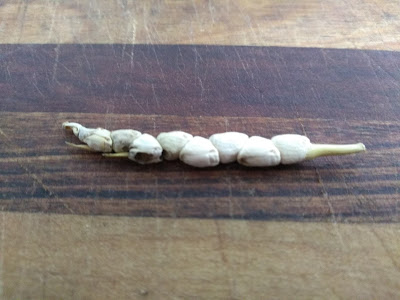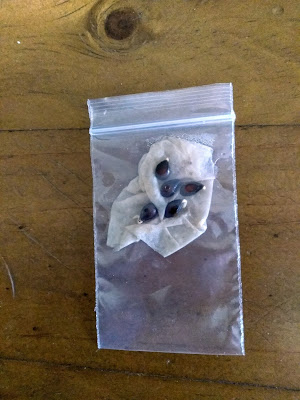Last summer I grew some perennial corn Zea diploperennis. I am very excited to say that some of my perennial corn plants survived winter and now that the weather is warming are happily growing!
Zea diploperennis is a perennial undomesticated ancestor of our modern corn. I am not sure if this particular species was used in breeding modern corn, or if it is just closely related to the species that were used in breeding domestic corn. What I do know is that it crosses with modern corn and with various undomesticated teosinte corn species.
My understanding is that perennial corn is pretty uncommon, and it is incredibly rare in Australia. I had never grown, or even seen, perennial corn plants before so this was somewhat of an adventure and a learning curve.
The cobs from diploperennis were small and contain far fewer seeds than domestic corn. I don't know if first year cobs are smaller than subsequent year cobs, but have a feeling that they are never large and never contain huge amounts of seed.
All modern corn varieties are annual which is great for large scale chemical dependent monocropping. A perennial corn would be wonderful for home growers, permaculture farming, and low input polyculture food forests. Perennial corn plants are simple to grow and resistant to may pests and diseases that affect modern corn, which makes them useful in breeding something that is better suited to backyard growers who don't want to spray anything.
I am told that this corn contains roughly 85% diploperennis genetics and about 15% domestic corn genetics. Having a small percentage of domestic corn genetics should mean that this will flower around the same time as other corn varieties, making it easier to cross breed and produce a perennial popcorn or perennial dent corn.
 |
| Z diploperennis divided into two plants - red stems |
I'm not sure how perennial corn would grow in a warmer climate, but where I am it dies back to rhizomes over winter. Some plants have robust rhizomes that appear to have divided a lot, while others had weaker rhizomes that did not divide at all.
Perennial corn is not well suited to my climate, the frosts are just too harsh here. It would be well suited to conditions with milder winters. I was uncertain if it could survive winter here but I did not want to grow it from seed each year and have yet another perennial vegetable that I treat as an annual.
To give it the best chance of surviving I grew it in pots which I moved to an unheated greenhouse over winter. This meant that it was still very cold, but the soil would not freeze. I learned a lot from this, and by in large it was successful. I believe that this would probably survive in the field if it was mulched.
 |
| Perennial corn flowering |
You may be able to tell in the photos, but I did not remove the previous year growth. This was partly because the leaves stayed green and alive for much of winter, and partly because I thought they would help protect the growing points slightly. Now that they are actively growing again it is time to remove the old growth.
 |
| Zea diploperennis dividing into many plants |
One of my plants divided into several plants, I am not sure how many but it is a decent number. This plant also had several stalks in its first year, and was the only of my plants to do this. This is a trait that I want to keep when I try to breed perennial popcorn.
I certainly don't want to reduce genetic diversity in the population at this stage so will not be only breeding from this dividing plant. Given that it does produce multiple stems I assume it will produce a lot of pollen and will likely incorporate its genes into a lot of the seeds produced by my plants.
From careful poking around in the soil it appears that this plant produced several rhizomes which probably could have been split off from one another and transplanted. These second year plants are certainly larger than seed grown at this stage, (especially considering that I have not yet planted corn seed for the year) so it will be interesting to see if they are more productive than first year plants.
Even if I never successfully cross this with modern corn this vigorously dividing trait would still be useful and highly desirable. Even if I simply breed a population of dividing plants they can be used similar to other cereals such as wheat o oats, but with much larger seeds that are more nutritious and are far simpler to thresh at home.
 |
| Zea diploperennis cob |
I have not divided anything yet as I have so few plants to play with and would hate to accidentally kill one. Instead I am leaving all of these surviving plants as they are to see how they perform in their second year and hopefully produce far more cobs per plant.
As you can see in the photo, the first year cobs were tiny. I have a feeling that they could double or triple this size. In other words I think that they will always be really small unless it is crossed with domestic corn.
 |
| Zea diploperennis cob size |
I wonder if a clumping plant like this would be more productive or less work than a plant with a single stem as it may produce numerous little cobs. It would be nice to be able to plant a perennial corn rhizome and then leave it to form an expanding clump that was increasingly productive each year. The only way for me to find out if this is possible is for me to leave it and see what happens.
This year I don't have any spare plants or seed to share. Hopefully all goes well and in autumn I will have spare seed and hopefully even some rhizome divisions from my more vigorous plants.
If you are in Australia and interested in growing perennial corn feel free to get in touch with me around autumn/winter to see if I have any seeds to spare. You can either leave a comment below or my contact details can be found on my for sale page.













































